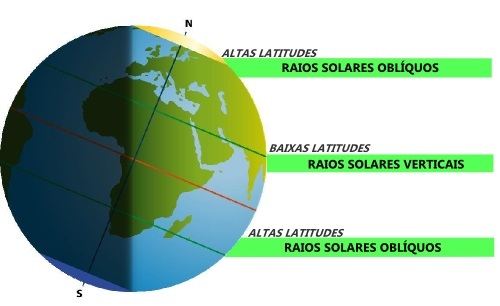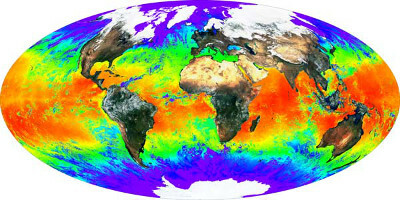There is a complex set of Climatic factors, that is, natural phenomena that interfere and modify the climate. For didactic reasons, we usually analyze them separately in order to better understand the influence of each of these factors on climate dynamics, even though there is no climate type in the world that is exclusively shaped by a single cause.
In this sense, one of the most analyzed phenomena is the relationship between latitude and climate. To understand this relationship, it is necessary to understand how the incidence of sunlight on the different areas of the Earth's surface, as well as the existence of the tilt of the axis of rotation of our planet, which is of 23,27º. Look at the figure below:

Incidence of sun rays during the summer solstices in the Northern Hemisphere
In the image above, we have an illustrative schematic of the summer solstice in the Northern Hemisphere, when the days are longer than the nights in that hemisphere. We realized that, even at this time, when the zone of illumination of the sun's rays on the Earth is uneven, the low areas latitudes, which are close to the equator, receive more intense illumination from the sun's rays, which fall in a vertical. In regions of high latitudes, closer to the polar zones, the sun's rays fall obliquely, with greater intensity in summer and less intensity in winter.
Do not stop now... There's more after the advertising ;)
Therefore, regardless of the season, equatorial zones receive more heat from the sun than polar bands. With this, the following relationship between climate and latitudes is established: the lower the latitude, the higher the temperatures and vice versa. In other words, the closer you are to the Equator, the warmer the climate is usually. Therefore, the climate bands of the planet.

Image released by NASA. Red areas have higher temperatures
In this other image, we have the representation of the Earth's temperatures throughout the year, indicating how regions with lower latitudes tend to be more warmer than the polar areas, although other regional factors can modify the variation of temperatures and humidity in different places, such as The altitude, vegetation and others. An example that latitude does not act alone is some areas of the Andes Mountains that, even though they are close to the equator, remain at low temperatures due to high altitudes.
The latitude and other climatic factors are of fundamental importance for understanding the diversity of climates covering the earth's surface, which interferes not only in the way of life of different societies, but in the dynamics of fauna, flora and other elements of nature.
By Me. Rodolfo Alves Pena
Would you like to reference this text in a school or academic work? Look:
PENA, Rodolfo F. Alves. "The relationship between latitude and climate"; Brazil School. Available in: https://brasilescola.uol.com.br/geografia/a-relacao-entre-latitude-clima.htm. Accessed on June 27, 2021.
